Lesson 2: Managing an Exchange Server 2003 Cluster
Once you have installed Exchange Server 2003 on a Windows Server 2003 cluster, there are additional administrative tasks to perform in order to create the Exchange Server 2003 virtual server. Even after you have set up the Exchange Server 2003 virtual server, you can manage details about the cluster and the services that run on it. Some of the settings include how long a service will be unresponsive before restarting, the timeframe after which to allow a failover, and whether to allow automatic or manual failback.
After this lesson, you will be able to
-
Create an Exchange Server 2003 virtual server
-
Manage Exchange Server 2003 clustered services
Estimated lesson time: 60 minutes
Creating an Exchange Server 2003 Virtual Server
The final step in configuring Exchange Server 2003 to run on a Windows Server 2003 cluster is to create the Exchange Server 2003 virtual servers. The number of Exchange Server 2003 virtual servers you need to create depends on whether you are creating an active/passive or an active/active cluster. If you are setting up a two-node active/passive Exchange Server 2003 cluster, you will be setting up one Exchange Server 2003 virtual server. If you are setting up a two-node active/active Exchange Server 2003 cluster, you will set up two Exchange Server 2003 virtual servers, since both server nodes will be active. You must repeat this step for each active node that will run an Exchange Server 2003 virtual server. In the practice at the end of this lesson, you will create an Exchange Server 2003 virtual server on Server01.
Each Exchange Server 2003 virtual server consists of a static IP address, a unique network name, a shared physical disk, and an Exchange System Attendant resource. You create each resource individually, in turn, in Cluster Administrator. Using Cluster Administrator, first you create the network and disk resources, and then you create the Exchange System Attendant resource. After you successfully create the Exchange System Attendant resource, Exchange System Attendant automatically creates all the other resources for the Exchange Server 2003 virtual server. The Exchange System Attendant resource creates the following resources, which are shown in the Cluster Administrator window in Figure 6-6:
-
Exchange Message Transfer Agent Instance
-
Exchange Information Store Instance
-
Exchange Routing Service Instance
-
Exchange MS Search Instance
-
SMTP Virtual Server Instance
-
Exchange HTTP Virtual Service Instance
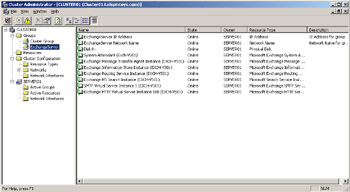
Figure 6-6: An Exchange Server 2003 virtual server configuration
The Message Transfer Agent Instance resource is created only in the first Exchange Server 2003 virtual server added to a cluster. All Exchange Server 2003 virtual servers in the cluster share the single Message Transfer Agent Instance resource.
Managing Exchange Server 2003 Clustered Services
After creating the Exchange Server 2003 virtual server, there are additional configuration options for determining how the cluster handles the Exchange Server services. These configuration options are managed in Cluster Administrator. In most cases, the default settings are adequate, but should you need to change a setting, you can.
One set of settings you might configure is how the group fails over and fails back. Figures 6-7 and 6-8 show the Failover and Failback property dialog boxes for the Exchange Server 2003 virtual server. On the Failover page, you can configure the number of times the node is allowed to failover (Threshold) during the period, which is defined in hours. If the node exceeds the threshold, it is taken offline and the Cluster Service does not attempt to bring the server back online. On the Failback dialog box, you see that the default behavior is to not allow automatic fail back when the server node returns to online operation. If no fail back policy is configured, the group will run on the alternate node until another failover situation occurs that causes the group to failover to the original node. In order to have resources fail back, you must configure a policy. When you configure a fail back policy, you have the option to fail back immediately or only between certain hours. Immediate failback can be undesirable because it could occur in the middle of the business day. During a fail back, the active services are taken offline while they are failed back to the original node, at which point they will be brought back online. The failback process can take up to 15 minutes, which will result in a disruption of service. Therefore, it is generally better to configure a failback period after business hours or during a slow time on the network. To set the time on the policy, use the twenty-four-hour system of expressing time, with 0 being 12:00 A.M. and 23 being 11:00 P.M.
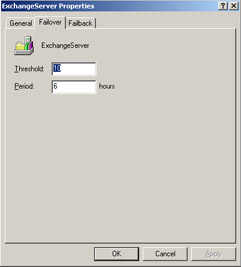
Figure 6-7: Server node failover properties
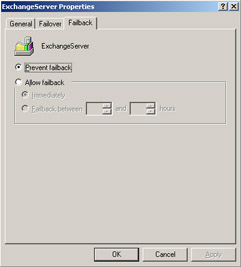
Figure 6-8: Server node failback properties
You can also right-click any of the resources listed in Cluster Administrator (such as those shown in Figure 6-6) and click Properties to access property tabs, which allow you to configure dependencies if you need to make changes for a resource. If you click the Advanced tab in the properties of any resource, you will see a dialog box like that in Figure 6-9.
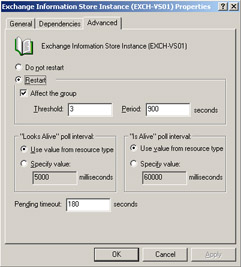
Figure 6-9: Advanced resource properties
On the Advanced tab, you configure settings for only the specific resource. In this example, the properties of the Exchange Information Store Instance are being edited. Here, you can define what happens if the individual resource fails on a server node. By default, resources will attempt to restart according to the threshold that is set. With the Affect The Group option selected, when the resource attempts to failover, it increments the group's failover count by one. This group count directly ties to the threshold set on the group's failover policy, as shown in Figure 6-7. If you clear the box for the Affect The Group option, the resource failing over does not increment the group failover count. When enough resource failovers occur to cause the group count to reach its threshold, or the individual resource threshold is reached, the entire group fails over to another node on the cluster.
When you first deploy a cluster, it is a best practice to test the restart, failover, and failback policies. This allows you to ensure that they function correctly prior to a real failure occurring. Cluster Administrator allows you to manually initiate a failure by right-clicking a resource and clicking Initiate Failure. You can cause resources to restart according to their restart policy this way, including causing the entire group to failover to another node.
Another way to test the failover policy is by manually stopping the cluster service on a server node. To do this, click the node you want to failover in the Cluster Administrator console, and then click the File menu and click Stop Cluster Service. This will cause an immediate node failure and cause the configured failover to occur. You can then start the service again and test the failback policy, if one is configured.
Practice: Managing an Exchange Server 2003 Cluster
In this practice, you will create an Exchange Server 2003 virtual server and, in the process, create the necessary IP address resource, network name resource, disk resource, and System Attendant resource.
Exercise 1: Create an Exchange Server 2003 Virtual Server
The first task is to create a new group for the Exchange Server 2003 resources. While you could use the existing Cluster Group set up by Windows, it is recommended that you store application resources in their own groups.
-
On the first node of the cluster, from the Start menu, point to Administrative Tools, and then click Cluster Administrator. Right-click the Groups container, point to New, and then click Group.
-
The New Group Wizard starts. In the Name field, type ExchangeServer for the name of this Exchange Server 2003 cluster group.
-
On the Preferred Owners page, verify that there is either one or no cluster nodes listed in the Preferred Owners box, and then click Finish. The new Exchange Server 2003 virtual server (cluster group) is displayed under Groups.
Note If the Preferred Owners page contains both nodes in the cluster, configure the order of the list on the second server node as the opposite of the list on the first node. For example, if the Preferred Owners list on the first node lists Server01 and then Server02, configure the second node to list Server02 and then Server01.
Exercise 2: Create an IP Address Resource
-
Right-click the Exchange Server 2003 virtual server, point to New, and then click Resource.
-
The New Resource Wizard starts. On the New Resource page, type ExchangeServer IP Address.
-
From the Resource Type drop-down list, select IP Address. Verify that the Group box contains the name of your cluster group, as shown in Figure 6-10, and then click Next.
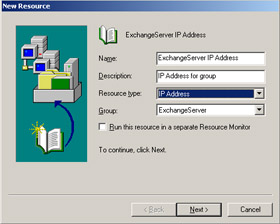
Figure 6-10: Configuring the resource type -
On the Possible Owners page, verify that Server01, which has Exchange Server 2003 installed on it, appears in the Possible Owners list, and then click Next.
-
On the Dependencies page, verify that no resources appear in the Resource Dependencies list, and then click Next.
-
On the TCP/IP Address Parameters page, in the Address box, type the static IP address of the Exchange Server 2003 virtual server. This should be an address that works on your public network, yet is unique to any other already assigned to the physical server or to the cluster.
-
Verify that the subnet mask for the Exchange Server 2003 virtual server is correct and that the LAN connection to the public network is selected, and then click Finish.
Exercise 3: Create a Network Name Resource
-
Right-click the Exchange Server 2003 virtual server, point to New, and then click Resource.
-
The New Resource Wizard launches. On the New Resource page, type ExchangeServer Network Name.
-
In the Resource Type list, click Network Name, and then click Next.
-
On the Possible Owners page, verify that Server01 appears in the Possible Owners box, and then click Next.
-
On the Dependencies page, click the IP Address resource for this Exchange Server 2003 virtual server in the Available Resources list, and then click Add. Click Next.
-
On the Network Name Parameters page, shown in Figure 6-11, in the Name field, type a name, such as Exch-VS01 (Exchange Virtual Server 01), for the Exchange Server 2003 virtual server. This name is the network name that identifies the Exchange Server 2003 virtual server on your network. Click Finish when done.

Figure 6-11: Configuring the network name
Exercise 4: Add a Disk Resource to the Exchange Server 2003 Virtual Server
In this exercise, you will create a new disk resource. You must create a disk resource for each disk that you want to associate with the Exchange Server 2003 virtual server. Disk resources must be SCSI disks and connected through SCSI or Fibre channel. If you attempt to use an Integrated Device Electronics (IDE) disk, you will be able to create the resource but not to bring it online later. If the resource you want to add already exists in another group, you can move it from the other group. If the disk resource you want to add does not yet exist, you must create it.
-
Right-click the Exchange Server 2003 virtual server, point to New, and then click Resource.
-
On the New Resource page, type Disk <drive letter>, where drive letter is a logical drive on the disk. For the description, use something descriptive, such as Disk F: Log Files (substitute the drive letter you use).
-
In the Resource Type list, click Physical Disk, and then click Next.
-
On the Possible Owners page, verify that Server01 appears in the Possible Owners list, and then click Next.
-
On the Dependencies page, verify that no resources appear in the Resource Dependencies list, and then click Next.
-
On the Disk Parameters page, select the disk you want. If the disk does not appear here, it means that either another cluster group already has defined a resource for it or it was not successfully installed.
-
Click Finish. The disk resource appears as a resource of the Exchange Server 2003 virtual server.
Exercise 5: Create an Exchange Server 2003 System Attendant Resource
-
In Cluster Administrator, right-click the Exchange Server 2003 virtual server, and then click Bring Online. You will see each of the resources go from Offline to Online Pending to Online.
-
Right-click the Exchange Server 2003 virtual server, point to New, and then click Resource.
-
On the New Resource page, in the Name field, type Exchange System Attendant - (Exch-VS01).
-
In the Resource Type list, click Microsoft Exchange System Attendant, and then click Next.
-
On the Possible Owners page, verify that Server01 appears in the Possible Owners list, and then click Next.
-
On the Dependencies page, select both the Network Name and Physical Disk resources for this Exchange Server 2003 virtual server in the Available Resources list, and then click Add. Click Next.
-
On the Data Directory page, verify the data directory location. You must verify that this location points to the shared physical disk resource assigned to this Exchange Server 2003 virtual server. Exchange Server 2003 will use the drive you select in this step for storing the transaction log files, the default public store files, and the mailbox store files (Pub1.edb, Pub1.stm, Priv1.edb, and Priv1.stm). Click Finish.
-
Right-click the Exchange Server 2003 virtual server, and then click Bring Online.
If you are creating an active/active cluster, you must repeat these exercises again on the second node, such as Server02. In an active/passive configuration, you must repeat the processes on each server node in the cluster that will be active. If you are creating a two-node active/passive Exchange Server 2003 cluster, you are done. If you start Exchange System Manager and expand the Servers container, you will see the new Exchange Server 2003 virtual server, Exch-VS01, as shown in Figure 6-12.

Figure 6-12: The new Exchange Server 2003 virtual server
Lesson Review
The following questions are intended to reinforce key information presented in this lesson. If you are unable to answer a question, review the lesson materials and then try the question again. You can find answers to the questions in the "Questions and Answers" section at the end of this chapter.
-
You are the administrator of a two-node active/passive Exchange Server 2003 cluster that is currently not in production but is being tested prior to being put into production. You are testing your failover policies, so you initiate failures on several resources until the group failure threshold is reached. The server successfully fails over the group to the formerly passive node, and the previously active node becomes passive. You want the group to fail back to the original service, but after an hour of waiting, the group is still running on the second node. It is late in the day so you decide to go home and deal with it the next day, since the cluster is not yet in production. The next morning, you notice that the cluster is still running on the second node, and you can't find a command in the Cluster Administrator GUI to initiate a failback. What can you do to get the group back on the original server node?
-
You are setting up a test server to practice with the cluster service as a prelude to a later cluster deployment. You don't have any real servers available, but you know that you can use a single system and a local quorum disk resource for testing purposes. You set up a desktop workstation class machine that has a SCSI C drive and an IDE D drive and 512 MB of RAM with Windows Server 2003, Enterprise Edition, and then you install the clustering service and Exchange Server 2003. You create the IP address, the network name, and the physical disk resources. However, when you attempt to bring the group online, the process fails. Why?
-
You are the administrator of an Exchange Server 2003 virtual server on a two-node active/active cluster running Windows Server 2003, Enterprise Edition, on each node. You know that Windows Server 2003, Enterprise Edition, supports eight-node clustering, so you decide to add two additional active nodes to your Exchange Server cluster. You install Windows Server 2003, Enterprise Edition, on two additional servers and successfully add them to the cluster. You then install Exchange Server 2003 successfully on the new servers. However, when you attempt to create the virtual servers, you find that you are unable to, even though you have the correct permissions to do so. What is the problem, and how can you solve it?
Lesson Summary
-
By default, cluster groups that failover to another node do not automatically fail back.
-
In order for cluster groups to fail back, you must create a failback policy.
-
An Exchange Server 2003 cluster group consists of an IP address resource, a network name resource, a physical disk resource, and an Exchange System Attendant resource.
-
The Exchange System Attendant resource installs all the additional Exchange Server resources.
EAN: 2147483647
Pages: 221